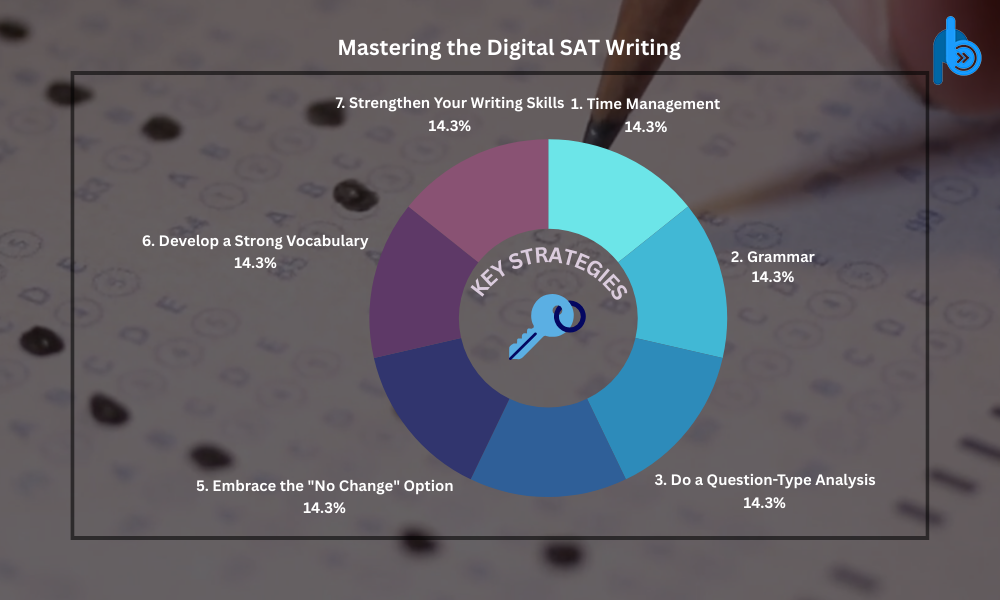The SAT Writing section can be a roadblock on your college journey. Fear not! By understanding the Digital SAT’s format and applying these tips, you can conquer this section and improve your overall score. Let’s Dive into the Do’s and Don’ts Of Digital SAT writing section and ace that test! You got it
Digital SAT Writing: A New Era of Testing
As of December 2023, the SAT has transitioned to a digital format, bringing about significant changes. The SAT Writing section is no exception. Familiarize yourself with these crucial updates:
- Shorter Test: The Digital SAT Writing is shorter than its paper-and-pencil predecessor, with a reduced testing time. This emphasizes the importance of effective time management and strategic question-solving.
- Adaptive Delivery: The test adapts to your performance, presenting questions of varying difficulty based on your previous answers. This personalized approach necessitates a strong grasp of fundamental grammar rules and a flexible test-taking strategy.
- Multi-Select Option: Some questions might have you select multiple answer choices that contribute to the correct response. This requires careful analysis of the passage and identifying all relevant elements.
Mastering the Digital SAT Writing: Key Strategies

Now, let’s delve into the core strategies that will empower you to conquer the Digital SAT Writing:
1. Time Management
- Practice Under Pressure: Simulate the test environment by taking timed practice tests on digital platforms offered by the College Board or reputable prep companies. This helps you get accustomed to the digital interface and develop a time-conscious approach.
- Prioritize Efficiency: Don’t get bogged down on a single question. If you find yourself stuck, flag it and move on. You can revisit flagged questions if time permits at the end.
- Manage the Clock: Allocate a specific time for each question type based on its complexity. Focus on answering most questions correctly rather than spending excessive time on a few.
2. Grammar:
- Brush Up on the Basics: Revisit and solidify your understanding of fundamental grammar rules, including subject-verb agreement, comma usage, pronoun usage, sentence structure, and parallelism.
- Targeted Practice: Identify your grammar weaknesses through practice tests. Focus your study efforts on areas that challenge you the most. Utilize prep resources that offer targeted practice drills for specific grammar rules.
- Internalize, Don’t Memorize: Don’t just memorize grammar rules. Strive to understand the logic behind them. This deeper understanding will equip you to tackle even unfamiliar sentence constructions.
3. Do a Question-Type Analysis:
- Deconstruct the Digital SAT Writing: Familiarize yourself with the different question types commonly encountered in the Writing section. These might include identifying sentence errors, improving sentence clarity and conciseness, strengthening transitions, and enhancing overall rhetorical effectiveness.
- Develop a Strategic Approach: Tailor your approach based on the question type. For instance, when identifying sentence errors, actively search for grammatical mistakes in each answer choice. When improving clarity, focus on options that enhance the flow and coherence of the passage.
- Practice Makes Perfect: Expose yourself to a wide range of question types through official practice tests and prep materials. The more diverse questions you encounter, the more comfortable you’ll be on test day.
4. Harness the Power of the Passage:
- Active Reading is Key: Don’t passively skim the passage. Actively engage with the text, highlighting key points and transitions. Annotate the passage to identify areas that might be flagged for improvement in the questions.
- Context is King: When evaluating answer choices, consider the context of the surrounding passage. The correct answer should seamlessly integrate with the overall flow and meaning of the text.
- Maintain a Critical Eye: Don’t be swayed by answer choices that simply sound good. Analyze each option critically, ensuring it adheres to proper grammar and strengthens the passage’s overall effectiveness.
5. Embrace the “No Change” Option:
- Don’t Fear the Default: The “No Change” option might be the correct answer surprisingly often (around 20% of the time). Don’t automatically assume a sentence requires correction. If the original sentence is grammatically sound and conveys the intended meaning clearly, “No Change” is likely the best choice.
- Process of Elimination: If you’re unsure about the “No Change” option, employ the process of elimination. Scrutinize the other answer choices, identifying any grammatical errors or instances where they weaken the passage’s clarity, effectiveness or fluency. By eliminating flawed options, you can build confidence in the “No Change” choice if it appears.
6. Develop a Strong Vocabulary:
- Expand Your Word Bank: A robust vocabulary can be a game-changer in the Writing section. While obscure words might not be heavily tested, understanding a wider range of vocabulary allows you to better comprehend the nuances of the passage and identify answer choices that enhance its precision and sophistication.
- Contextual Learning: Don’t just memorize vocabulary lists in isolation. Actively learn new words by encountering them in context within reading materials like articles, novels, or high-quality prep resources.
- Utilize Mnemonic Devices: Employ memory aids like mnemonics or flashcards to solidify your understanding of new vocabulary words and their definitions.
7. Strengthen Your Writing Skills:
- Read Like a Writer: Immerse yourself in well-written prose. Read articles from reputable publications, classic literature, and high-scoring student essays. You may also read novels by certain authors that really take grammar into consideration. I personally would recommend Dan Brown novels which I utilized during my own SAT prep, and they proved to be a life saver of sorts. Be conscious and pay attention to how authors use grammar, sentence structure, and vocabulary to convey their ideas effectively!
- Practice Makes Progress: Hone your writing skills by practicing regularly. Write on a variety of prompts, focusing on clarity, conciseness, and persuasive arguments. Consider seeking feedback from teachers, tutors, or peers to identify areas for improvement.
- Embrace Active Voice: The Digital SAT Writing generally favors active voice over passive voice. Active voice sentences are typically clearer, more concise, and more engaging for the reader.
Conclusion: Mastering the Digital SAT Writing
By incorporating these strategies and practicing diligently, you can develop the skills and confidence necessary to excel in the Digital SAT Writing section. Remember, the key lies in a strategic approach, a solid foundation in grammar rules, and a commitment to continuous improvement. With focused preparation and a positive mindset, you’ll be well on your way to conquering the Writing section and achieving your desired SAT score.
More Relatable Blogs from this Author:



























